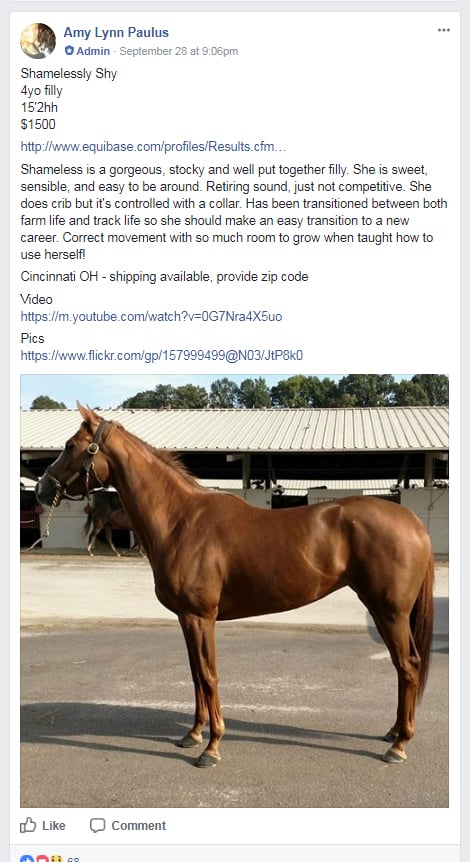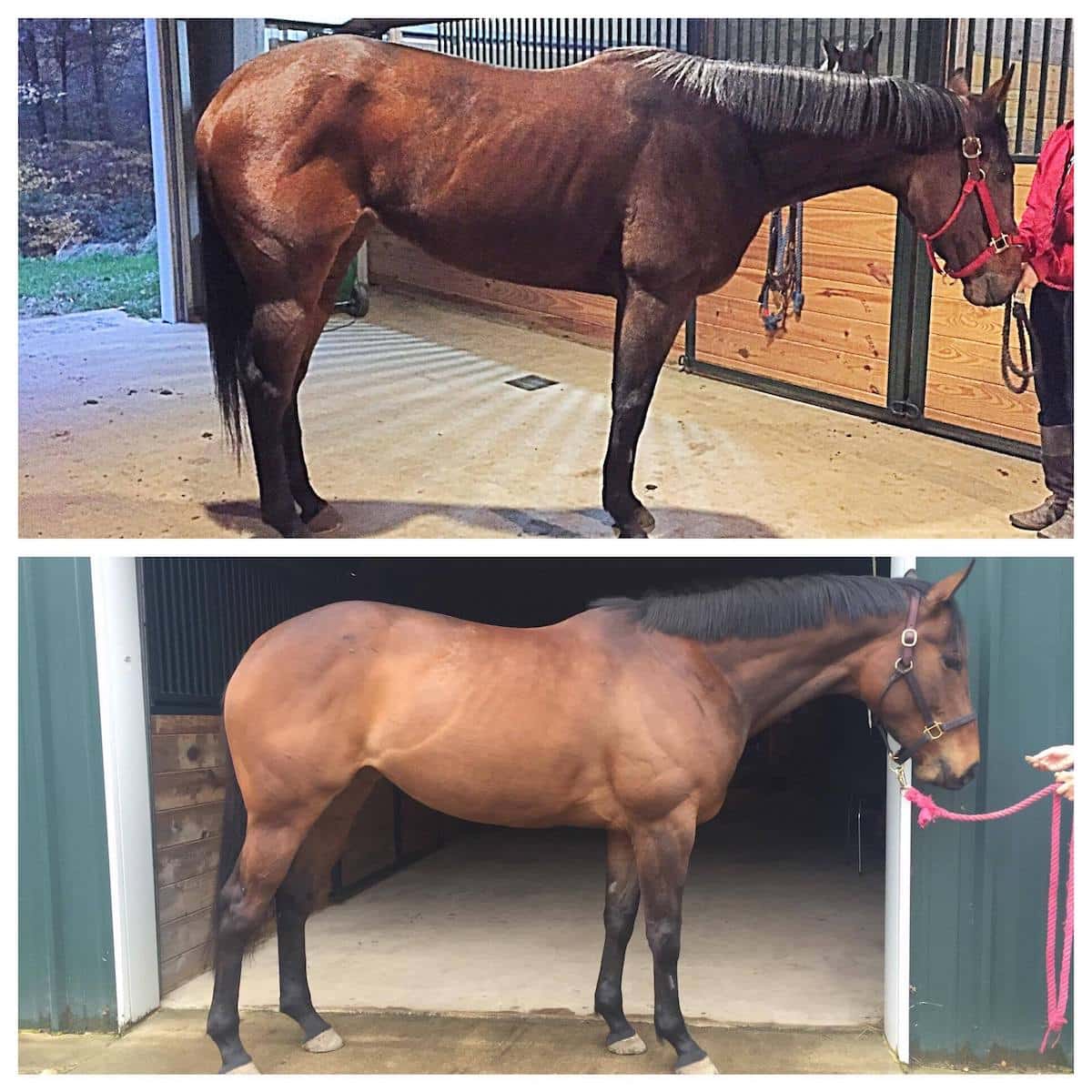With the advent of social media, shopping for an OTTB became easy and fun. But there are some things the savvy shopper should know before saying “yes” to a pretty face online.

Courtesy The Horse staff
If you love Thoroughbreds, you might dream of buying that off-track treasure who turns out to be the next Anthony Patch (Laine Ashker’s Rolex horse) or Blackfoot Mystery (Boyd Martin’s Olympic mount). Even if competition isn’t your goal, Facebook posts of people having fun with their OTTBs can make you eager to buy one yourself.
Anytime you’re thinking of buying a horse, it pays to be realistic about your abilities, budget, dreams and access to good help. Those considerations are especially relevant when you’re buying a retired racehorse — a high-energy athlete with a largely unknown history.
An advantage of online shopping is that you can look through dozens of ads and narrow your choices from the comfort of your own home. Once you do, keep these considerations in mind to improve your chances of landing the OTTB of your dreams.
Starting Point
Today it’s rare to find a horse advertised online that is still at the track. Most often, horses offered for sale or adoption are at least one step off the track, in the hands of a dealer, trainer or aftercare organization. Nonetheless, it’s worthwhile to understand on-track life, so you can better evaluate the horse that’s just retired.
A racehorse is an elite athlete. He leads a structured life. It’s intense, but the routine makes it work for him. He eats high-octane food so he can blast out of the starting gate and run fast. He lives in a stall 23 hours a day and does exciting stuff when he’s taken out. Because of time and staff limitations, horses are usually handled assembly-line style, and the horse is accustomed to that routine. He’s tied to the back wall, groomed, his feet picked, saddled and led out to work. Woo hoo! So when you look at a horse on the track (or just off the track), that’s how you’re going to see him. He might have had the best of care, but he’ll likely be “up,” physically and emotionally. You might also run into a few surprises. For instance, he’s probably used to having his feet picked up from his left side. So if you run your hand down his right leg from his right side, he might not know what you want and be jumpy about the unfamiliar approach.
If you hear of a horse at the track ready for a new home, you must be ready to act. You can’t call on Monday and say you’ll look at him on Friday. Chances are the trainer needs the stall for a paying client, so he can’t hold the horse the way a private farm might. And forget about “trying” the horse. Trainers can’t assume the liability of having various riders on the horse’s back.
When it comes to getting a horse’s history, the trainer can only tell you what he or she knows. Chances are the horse has had several owners or at least been in several training barns. The trainer retiring him might not know his history, other than racing-related. So the person who takes the horse directly from the track takes him as-is. No guarantees and no come-backs, which is one big advantage to working with a dealer or an aftercare organization.
Away from the track, the horse begins to adjust to a new place, new people, new horses, new routine. He might be worried, body-sore or dealing with old injuries. Depending how long he’s been off the track, the condition he was in when he retired, his temperament and the handling or training he received at the facility, he’ll start to make physical as well as emotional changes.

Halter for Sale
If you follow any of the OTTB groups on Facebook, you know the social network prohibits the sale of animals on its site. So users have gotten creative about promoting horses available for purchase: “Halter for sale! Includes 16.2-hand OTTB, sound, ready to go.”
Online photos are snapshots, moments in time. Realize the norm is for a racehorse to have a powerhouse front end. Newly retired racehorses usually have a well-developed shoulder, slender neck, lean barrel and small hindquarter. It takes vision and experience to imagine that horse filled out.
You really have to develop the knack of looking at conformation — the horse’s bone structure, not just his body condition. It often pays to get an expert’s opinion. Another advantage of online shopping is that you can send the photos to people whose opinion you value and get their input. Talk with people showing their OTTBs, and ask if you can see what their horses looked like coming off the track.
Amy Lynn Paulus, creator of the Facebook group Paulus Racing and Performance Thoroughbreds, sells many off-track horses. She frequently helps people envision what muscles will develop with work.
“Many of these horses are uneven,” she says. “They don’t get a lot of trotting, bending or the advantage of hill work. Change their feed, work them differently and they’ll develop different muscles and a topline. That’s hard for someone who hasn’t retrained a few to visualize.”
She also suggests buyers seriously consider their own abilities. That way they aren’t overfaced, injured or discouraged, and the horse doesn’t come back for rehoming. She says many people have a minimal budget, so they end up taking home what they can afford. But if that horse doesn’t meet their needs or has extensive expenses, they get in over their heads financially. Online research can help narrow the criteria.
People selling or considering buying a horse often post photos, asking for comments. Don’t believe everything you read, but within those comments will be considerations you might never have thought about. You might not have noticed he looks “tied in” behind the left knee, for instance, or that he has a club foot. While it could just be the camera angle, put these things on your questions-to-ask list.

You have to be able to envision what a horse will look like after he adjusts to his new lifestyle and develops different muscles and a topline. Courtesy Amy Paulus
Who Are You Dealing With?
When you’ve narrowed the search, call the people promoting the horses you’re interested in. Ask each seller what he or she knows about the horse — history, temperament, soundness, health, quirks, ease of handling and so forth. Jot all those things down, especially small comments that might not seem significant at the time. Ask where the horse has been since he’s left the track.
Don’t worry about asking a “stupid” question. Ask whatever is important to you. Equestrians are notorious for using terms that have several meanings, such as the horse having a “good temperament,” being “lightly restarted” or being a “good mover.” Those phrases mean different things to racehorse people than they do to dressage or ranch people, for instance.
Ask the seller about his or her background. You can find good horses in many places, so you don’t necessarily have to deal with someone who rehomes Thoroughbreds. But ask for references for that professional.
It’s particularly easy to research the reputation of resellers online. Have other buyers had good experiences? Was the horse as represented? If the dealer said he’d “stand behind the horse,” what did that mean? In this age of social media, a few questions posted courteously to an OTTB-focused online group can provide helpful background.
And what if the horse doesn’t work out for you? Most aftercare organizations and reputable dealers will rehome or help you rehome the horse. Realize you might lose money in the process, as you’ve likely put money, care or training into the horse.
If the horse is a distance away, you might ask the seller to send you a video of someone riding him, changing leads, working around the barn and more. That can help you minimize your search without logging too many miles.
Once the horse has been through the initial let down period (which varies from horse to horse) and begun to adjust to life away from the track, the seller might have started riding him. You or your trainer might be able to try the horse or at least spend time with and learn more about him before you buy. You’re purchasing the horse you see in front of you, not just what you saw in the online video.
Master horseman Bernie Traurig doesn’t recommend amateurs buy directly from the track or without trying the horse. “You don’t know what you’re getting,” he says. “You don’t know about temperament, soundness, talent. It’s too risky. If you buy something that’s a bad mover or poor jumper — or crazy — you have a problem.”
He advises buying from someone who has taken the horse from the track and given him a little time or training. “That way you can ride him, see what he feels like,” he says. “Ride him across a diagonal and see if he has a natural change of leads.”
Prepurchase Exam
We’ve all heard stories of the buyer who had a thorough prepurchase exam done on a horse, and yet a lameness still cropped up later. And we’ve heard of those who “went with their gut” and purchased without an exam and never had a problem. But considering you’re buying an athlete, it would be wise to have an exam done.
Realize that the “track vet” will do a very different exam than a sport-horse vet. The former is looking for general health and obvious current unsoundness. The latter is better able to help you assess the horse’s suitability for what you want to do. The cost of a prepurchase exam ranges from the basic $100 health exam to the big numbers when many X-rays are involved.
Here again, your online friends can help you zero in on questions you might want to ask about racehorse-specific health issues, such as ulcers, dental care, hoof condition, exercise-induced pulmonary hemorrhage (“bleeding”) and so forth. For instance, confirmed bleeders might warrant endoscopy.
Paulus recommends doing X-rays, at least of any joints with a known history of swelling or that the veterinarian senses might warrant further investigation. “We had a horse at the farm who was sound, looked and flexed great,” she says. “X-rays showed he had three screws in one ankle. No one knew.”
Take-Home Message
Given the ease of online shopping, romance can obscure reality. One can get wrapped up in a slick website presentation or sale video. Fortunately, given the tremendously supportive online community of OTTB enthusiasts, there’s no need to make a snap purchase decision. With so many horses available, you can afford to be choosy.
Even Experts Ask Experts
Repeat Retired Racehorse Project Thoroughbred Makeover winner Lindsey Partridge buys her Makeover horses sight unseen, in part because she likes proving that almost any Thoroughbred can be retrained successfully. After so many horses over the years, she pretty well knows what she’s looking at, but still encounters some surprises.
“I found (2015 Makeover contender) Lion of Wall Street on Facebook through a place that takes Thoroughbreds right from the racetrack and finds them homes,” she says. “He looked adorable with his flashy socks and blaze face. I had some professionals I trust look at his photos. They gave me the green light, so I purchased him.
“When I brought him home, his teeth were in horrible shape and needed extensive work. That wasn’t something I’d thought to ask about. However, he didn’t have any soundness issues, and he’s been a great horse. He won second place in Trail and 10th in the Freestyle at the 2015 Thoroughbred Makeover.”
This article was originally published in the Winter 2018 issue of Off-Track Thoroughbred Magazine, the only publication dedicated to the Thoroughbred ex-racehorse in second careers. Want four information-packed issues a year delivered to your door or your favorite digital device? Subscribe now!

